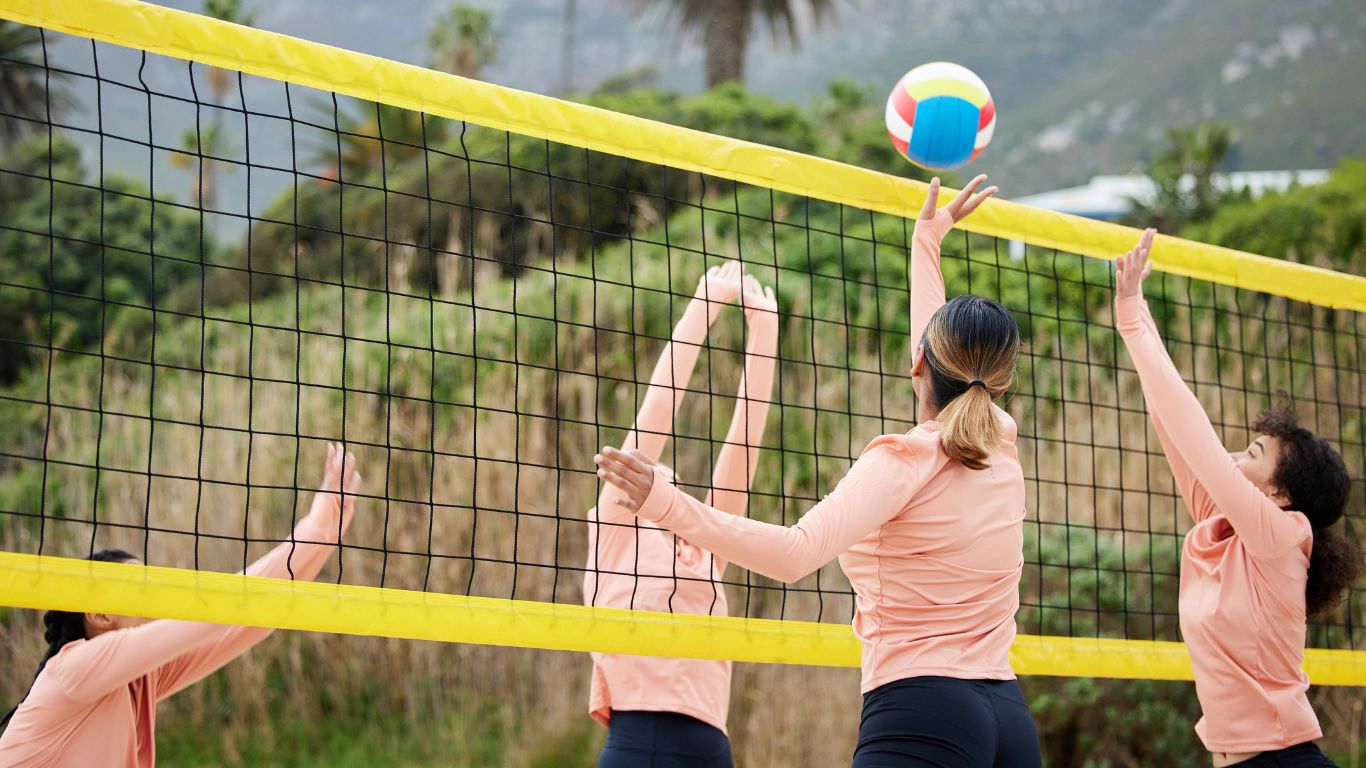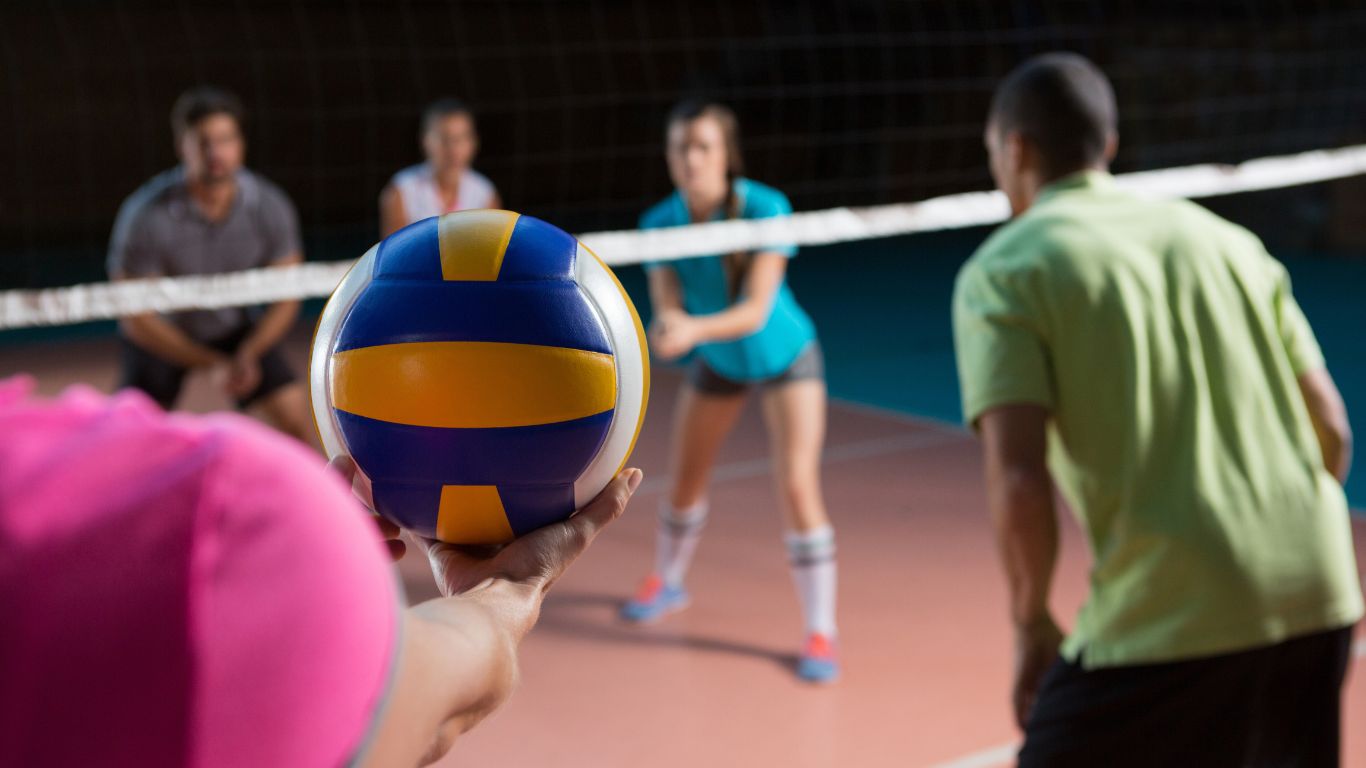Volleyball is a team sport played by two teams on a rectangular court, with the goal of hitting a ball over a net and preventing it from hitting the ground on their own side. Volleyball is a fast-paced, competitive sport that requires quick thinking, coordination, and teamwork.
It is played indoors and outdoors at both amateur and professional levels. With its roots dating back to the late 19th century, volleyball has evolved into a popular sport worldwide, with millions of players and fans. Whether you’re diving for a save, setting up a teammate for a spike, or strategizing with your team, volleyball offers excitement and challenge for all involved.
The Origins And Evolution Of Volleyball
Volleyball is a highly popular sport that has captivated the hearts of millions around the world. Its fast-paced and exhilarating nature make it an exciting game to watch and play. However, before volleyball became the dynamic sport it is today, it underwent a fascinating journey of invention and evolution. In this article, we will take a closer look at the origins and evolution of volleyball, exploring its humble beginnings, early adaptations, and international recognition.
Invention Of Volleyball
The invention of volleyball can be credited to William G. Morgan, a YMCA instructor from Holyoke, Massachusetts, USA. In 1895, Morgan created the game as an alternative to basketball, which was starting to gain popularity. Building upon elements of basketball, tennis, and handball, he aimed to develop a game that could be played indoors to keep athletes active during the winter season.
Morgan’s creation was initially referred to as “Mintonette.” The game quickly gained traction, with its unique characteristic of players hitting the ball over a net and trying to prevent it from touching the ground. Recognizing the game’s potential, Morgan showcased it at a YMCA physical education directors’ conference, where it garnered significant interest.
Early Adaptations Of The Game
As the game spread across different regions, it underwent several adaptations to enhance its competitive nature and align with the players’ evolving skills. In the early years, team sizes varied, with some games played with as few as six players on each side. It later evolved into the standard team size of six players.
Furthermore, the rules were refined to promote fair play and facilitate smoother gameplay. The concept of rotations was introduced, allowing players to take on different positions on the court, ensuring equal opportunities and strategic flexibility for all team members.
International Recognition And Growth
Volleyball’s international recognition began in 1947 when the International Volleyball Federation (FIVB) was established. The FIVB unified the rules and regulations of the game, providing a solid foundation for international competitions and fostering its growth on a global scale.
The sport made its Olympic debut in Tokyo 1964, solidifying its place among other distinguished sports. Since then, volleyball has continued to flourish, with the introduction of beach volleyball, which gained immense popularity in the 1990s. Today, volleyball is played at various levels, from local recreational matches to professional leagues and prestigious international tournaments.
The journey of volleyball’s origins and evolution showcases how a simple idea can transform into a worldwide phenomenon. From William G. Morgan’s innovative creation to the sport’s global appeal today, volleyball has undoubtedly carved its place in the annals of sports history.
Basic Rules And Gameplay
Volleyball is a popular team sport played worldwide. It involves two teams of six players each, aiming to score points by hitting a ball over a net and into the opposing team’s side of the court, while preventing the ball from hitting the ground on their own side.
The game follows specific rules and techniques to ensure fair play and exciting gameplay.
Basic Rules and Gameplay Volleyball is an exciting and fast-paced sport that involves two teams competing to keep the ball in the air and ultimately score points. Understanding the basic rules and gameplay of volleyball is essential to becoming a skilled player. In this section, we will explore the court setup, serving, passing and setting, attacking and blocking, and rotation and positions in volleyball.
Court Setup The volleyball court is rectangular in shape, measuring 18 meters long and 9 meters wide. It is divided into two equal halves by a net that stands at a height of 2.43 meters for men and 2.24 meters for women. The court is further divided into attack zones and back zones. Each team is allowed to occupy their respective zones during the game.
Serving Serving is how a player initiates the game by putting the ball into play. The server must stand behind the court’s end line and hit the ball over the net with an open hand or a fist. The ball must pass over the net and land in the opponent’s court. If the serve results in an error, the other team earns a point and takes over the serve.
Passing and Setting Once the ball is served, the receiving team must successfully pass the ball to a teammate using their forearm, known as a forearm pass. This technique allows for better control and accuracy. The setter then sets the ball by using their fingertips to deliver an accurate pass to a teammate who will attack the ball.
Attacking and Blocking Attacking is an essential aspect of volleyball, as it involves players spiking the ball over the net into the opponent’s court. This offensive move aims to score points and create difficulties for the opposing team’s defense. Conversely, blocking is the defensive technique used to stop or redirect the opponent’s attacks. Players position themselves near the net, jumping to block the spiked ball.
Rotation and Positions To ensure fairness and equal opportunities for all players, volleyball follows a rotational system. After winning a rally, the team rotates clockwise, allowing each player to occupy different positions on the court. The positions in volleyball include setters, outside hitters, opposite hitters, middle blockers, and liberos.
The rotation system ensures that all players have a chance to fulfill different roles during the game. Now that you have a better understanding of the basic rules and gameplay of volleyball, you can start practicing and honing your skills on the court. Stay tuned for our next section, where we will delve deeper into the techniques and strategies that make a successful volleyball player.
Volleyball Skills And Techniques
Volleyball is a dynamic and exhilarating sport that demands a combination of technical skills and strategic thinking. Players must master a range of techniques to serve, pass, set, attack, and block effectively. Each skill is fundamental to the game, contributing to a team’s performance and overall success. Let’s delve into the key volleyball skills and techniques that players need to excel in this fast-paced sport.
Serving Techniques
Serving is a crucial aspect of volleyball, as it initiates each rally. A well-executed serve can place the opposing team under pressure from the get-go. Some popular serving techniques include float serves, jump serves, and topspin serves. Players may opt for a conservative underhand serve for consistency or a more aggressive overhand serve to increase the chance of an ace.
Passing Techniques
Passing, also known as the “bump,” is vital for receiving serves and setting up the team’s offense. Players employ various passing techniques such as the forearm pass, overhead pass, and diving save to effectively control the ball. Accurate and controlled passes are essential to enable the setter to execute the next play and keep the rally alive.
Setting Techniques
The setter is responsible for delivering accurate and consistent sets to the hitters, allowing them to attack the ball. Setting techniques involve using the fingertips to deliver precise, well-timed sets to the attackers. A good setter must possess excellent hand-eye coordination and the ability to make split-second decisions to outplay the opponents.
Attacking Techniques
Attacking, also known as spiking, is one of the most thrilling aspects of volleyball. Hitters use a variety of attacking techniques, including power hits, tips, and roll shots, to outmaneuver the defense and score points. Successful attackers must possess agility, timing, and jumping ability to deliver powerful and strategic hits.
Blocking Techniques
Blocking plays a critical role in disrupting the opponent’s attack and providing a solid defense. Players need to master effective blocking techniques such as solo blocks, double blocks, and quick blocks to thwart the opposing team’s scoring attempts. Timing, positioning, and the ability to read the hitter are essential for successful blocking.
Developing Physical Fitness For Volleyball
Volleyball requires a high level of physical fitness, as players need to possess a combination of strength, speed, agility, flexibility, mobility, endurance, and cardiovascular fitness. Developing physical fitness for volleyball involves specific training techniques designed to enhance these aspects. Let’s explore the key components of physical fitness in volleyball and the training methods needed to excel in this dynamic sport.
Strength And Conditioning
Strength and conditioning are crucial for volleyball players to handle the demands of the sport. Training routines focus on building muscular strength and power, especially in the lower body and core. Exercises targeting major muscle groups such as squats, lunges, and deadlifts are incorporated to enhance explosiveness and stability on the court.
Speed And Agility Training
Speed and agility play a significant role in volleyball, as quick movements are essential for effective play. Training drills involving cone exercises, ladder drills, and shuttle runs are utilized to improve footwork, reaction time, and directional changes, enabling players to swiftly navigate the court.
Flexibility And Mobility
Flexibility and mobility are essential for preventing injuries and maximizing performance in volleyball. Stretching exercises and dynamic movements help maintain a full range of motion in joints, enhancing players’ ability to reach, dive, and maneuver during gameplay.
Endurance And Cardiovascular Fitness
Endurance and cardiovascular fitness are critical for sustaining the high-intensity nature of volleyball matches. Conditioning programs include aerobic exercises such as running, cycling, and interval training to build endurance and improve the cardiovascular system, ensuring players can maintain peak performance throughout the game.
Mental Preparation And Strategy
Prepare your mind and develop a strategic approach for volleyball. Mental preparation is vital for anticipation and quick decision-making during the game. Implementing effective strategies enhances team coordination and boosts overall performance on the court.
Building Focus And Concentration
One of the key aspects of mental preparation in volleyball is building focus and concentration. When playing volleyball, it’s important to stay focused on the game and not let distractions get in the way. To build focus and concentration, players can:
- Practice mindfulness and meditation techniques to clear their minds and stay present in the game.
- Set goals for each game or practice session to keep their minds focused on achieving specific objectives.
- Use visualization exercises to imagine themselves successfully executing different plays and strategies.
- Eliminate external distractions by creating a routine or pre-game ritual that helps calm and center their minds.
Developing A Positive Mindset
A positive mindset is crucial in volleyball as it can greatly impact a player’s performance on the court. By maintaining a positive outlook, players can:
- Stay motivated and overcome challenges with resilience and determination.
- Foster confidence in their abilities, which is essential for taking risks and making split-second decisions.
- Support their teammates and maintain morale even during difficult moments in the game.
- Learn from their mistakes and view setbacks as opportunities for growth.
Strategic Positioning And Communication
In volleyball, strategic positioning and effective communication are essential for a successful game. Players need to:
- Understand their role and position on the court, ensuring they are in the right place at the right time.
- Anticipate the movements of their teammates and opponents to react quickly and make precise plays.
- Communicate clearly and concisely with their teammates through verbal cues, hand signals, and non-verbal communication.
- Coordinate with their teammates to execute various strategies and tactics, such as setting up a successful spike or blocking an opponent’s attack.
Analyzing And Adjusting To Opponents
Another crucial aspect of mental preparation and strategy in volleyball is analyzing and adjusting to opponents. By studying their opponents, players can:
- Identify their strengths, weaknesses, and playing styles to develop effective strategies.
- Anticipate their opponents’ moves and adjust their positioning accordingly for strong defensive plays.
- Identify patterns and tendencies in their opponents’ gameplay to make informed decisions.
- Adapt their tactics and strategies throughout the game to counter the opponents’ strengths and exploit their weaknesses.

Credit: www.squawka.com
Common Mistakes And How To Avoid Them
When playing volleyball, it’s easy to make mistakes that can hinder your performance and your team’s success. Recognizing and avoiding these common errors is essential to becoming a skilled player. In this section, we will discuss some of the most frequent mistakes made in serving, passing and setting, attacking and blocking, as well as rotational and positioning, and provide tips on how to avoid them.
Serving Errors
Serving is one of the most crucial aspects of volleyball, and making errors in this area can be detrimental to your team. Here are some common serving mistakes to watch out for:
- Inconsistent toss: Failure to consistently provide a precise toss often leads to faulty serves. Practice your toss to ensure accuracy and consistency.
- Poor technique: Incorrect arm swing, improper hand contact, or lack of follow-through can significantly impact the quality of your serve. Work on your technique to generate more power and control.
- Serving too hard or too soft: Finding the right balance between a powerful serve and maintaining control is essential. Experiment with different serving techniques to strike a balance that works for you.
Passing And Setting Mistakes
Passing and setting are fundamental skills that require precision and communication. Here are some of the most common mistakes to avoid:
- Incorrect footwork: Poor footwork can lead to awkward positioning, affecting your ability to make accurate passes and setups. Focus on your foot positioning and movement to improve your passing and setting execution.
- Overrelying on arms: Relying solely on your arm strength to pass or set the ball can result in inconsistent and erratic plays. Utilize your legs and core for better stability and control.
- Lack of communication: Failure to communicate with your teammates can lead to miscommunication and errors in passing and setting. Practice effective communication on the court to enhance teamwork.
Attacking And Blocking Errors
Attacking and blocking require a combination of power, timing, and precision. Avoid these mistakes to become a more effective attacker and blocker:
- Incorrect approach: A flawed approach can hinder your ability to generate power and accuracy in your attacks. Ensure your footwork and timing are in sync to maximize your hitting potential.
- Ineffective swing technique: A weak swing or improper hand placement can result in subpar attacks. Focus on proper arm swing, wrist snap, and hand contact to improve your attacking technique.
- Poor timing and positioning: Failing to time your block correctly or being in the wrong position can render your blocking efforts ineffective. Practice reading the opponent’s movements to enhance your blocking skills.
Rotational And Positioning Mistakes
Understanding rotational and positioning concepts is crucial for efficient team play. Avoid these common mistakes:
- Miscommunication during rotation: Failure to communicate rotation shifts can lead to confusion and errors in positioning. Maintain open communication with your teammates to ensure smooth transitions.
- Incorrect positioning: Being out of position can result in missed opportunities and defensive vulnerabilities. Stay aware of court positioning and adjust accordingly to optimize your contribution to team defense.
- Lack of court awareness: A lack of awareness can lead to collisions with teammates, missed set opportunities, or defensive breakdowns. Continually scan the court and be aware of your surroundings to avoid mishaps.
By recognizing these common mistakes and actively working to improve your skills, you’ll become a more proficient volleyball player. Practice consistently, seek feedback, and remain dedicated to refining your technique to minimize errors and maximize your contribution to your team’s success.
Volleyball Equipment And Gear
When it comes to playing volleyball, having the right equipment and gear is essential. Whether you’re a beginner or a seasoned player, having the proper volleyball gear can greatly enhance your performance and keep you safe from potential injuries. In this section, we’ll discuss the different types of volleyball equipment and gear you need to bring your A-game to the court.
Choosing The Right Volleyball
Before you step onto the court, it’s important to choose the right volleyball. A good volleyball should be durable, have a soft touch for comfortable play, and provide a good grip to ensure precise ball control. Volleyballs come in various sizes and materials, so it’s important to consider the age and skill level of the players when making your selection. Additionally, make sure the ball is properly inflated to maintain optimal performance.
Essential Clothing And Footwear
Wearing the right clothing and footwear is crucial for comfort, agility, and mobility during a volleyball game. When it comes to clothing, opt for breathable and lightweight materials that help wick away moisture. This will keep you cool and dry throughout the game.
Additionally, choose fitting athletic shorts or spandex that do not restrict your movement. As for footwear, volleyball shoes are specifically designed to provide the necessary support and traction on the court. These shoes have non-marking soles to prevent scuffing and ensure stability when making quick movements.
Protective Gear And Equipment
While volleyball is generally considered a low-contact sport, accidents can happen. To minimize the risk of injuries, it’s wise to invest in some protective gear. Knee pads are essential for protecting your knees during dives and slides, while ankle braces can provide extra support and prevent sprains. Additionally, elbow pads can help protect against floor burns. It’s essential to choose gear that fits properly and stays securely in place during play.
Training Aids And Accessories
To improve your volleyball skills, there are various training aids and accessories available that can help you up your game. From agility ladders and resistance bands to jump training accessories, these tools can help enhance your speed, strength, and vertical leap. Consider incorporating some of these training aids into your practice sessions to take your skills to the next level.

Credit: www.amazon.com
Volleyball Drills And Exercises
Volleyball is a team sport that involves hitting a ball over a net using hands or arms. It requires teamwork, agility, and coordination. Volleyball drills and exercises are instrumental in improving skills such as serving, spiking, and blocking, enhancing overall performance on the court.
Serve And Receive Drills
Excelling in the fundamental aspects of serving and receiving is key to a strong performance in volleyball. Serve and receive drills are designed to enhance the accuracy, power, and coordination necessary in these critical elements of the game. One effective serve drill is the “Target Serving” drill, where players aim to hit specific targets within the opposing team’s court.
This drill improves serving accuracy and control while also adding an element of competition, keeping players engaged and motivated. To improve receiving skills, the “Pass and Set” drill is highly beneficial. Players form pairs, with one player passing the ball to their partner who then sets it back. This drill allows players to focus on their passing and setting techniques, enhancing their ability to handle different types of serves with precision.
Setting And Hitting Drills
The ability to set and hit the ball effectively is crucial for any volleyball player. Setting and hitting drills help refine technique, timing, and coordination, enabling players to execute accurate and powerful attacks. In the “Three-Person Pepper” drill, players form groups of three, with one person designated as the setter.
The three players engage in a continuous series of passes, sets, and hits, promoting quick decision-making and improving overall hitting and setting skills. Another beneficial drill is the “Attack and Block” drill, where players practice hitting against a blocker. This drill not only improves the hitter’s ability to find gaps in the opposing team’s defense but also enhances the blocker’s timing and positioning skills.
Blocking And Defense Drills
Blocking and defense are crucial aspects of volleyball that require solid technique, quick reflexes, and strong teamwork. Specific drills targeting these areas can greatly improve a player’s ability to defend against attacks and execute effective blocks. The “Block Shuffle” drill involves players shuffling along the net while actively blocking attacks from the opposing team.
This drill helps players develop quick footwork, timing, and blocking skills, ensuring a strong defensive presence at the net. Another effective drill is the “Dig and Dive” drill, where players practice diving to save the ball from hitting the ground. This drill enhances defensive skills and teaches players how to react quickly to unpredictable situations, promoting teamwork and effective communication.
Team Building Exercises
Building a cohesive and unified team is crucial for success in volleyball. Team building exercises not only improve communication and trust among players but also contribute to a positive and supportive team culture. One popular team building exercise is the “Trust Circle,” where players form a circle and take turns falling backward, trusting their teammates to catch them.
This exercise fosters trust and builds strong relationships among team members. The “Two Truths and a Lie” game is another effective team building exercise. Players take turns sharing two true statements and one false statement about themselves. The rest of the team must guess which statement is the lie, encouraging active listening, communication, and team bonding. By incorporating these various drills and exercises into their training sessions, volleyball players can improve their skills, enhance their team dynamics, and ultimately elevate their game to new heights.
Volleyball Competitions And Leagues
Volleyball competitions and leagues play a significant role in promoting the sport to a wider audience and providing opportunities for players to showcase their skills. From international competitions to college and high school leagues, volleyball offers a range of opportunities for players to engage in competitive play at various levels.
International Volleyball Competitions
International volleyball competitions bring together the best teams from around the world to compete for top honors. Events such as the FIVB Volleyball World Championships and the Olympic Games are highly anticipated and draw massive global viewership. These competitions not only showcase exceptional athleticism but also serve as a platform for countries to display their national pride.
National And Professional Leagues
National and professional volleyball leagues provide a platform for players to compete at a high level within their own countries. Leagues such as the Italian Serie A1, Brazilian Superliga, and the Russian Super League feature top-tier talent and intense rivalries. These leagues offer players the opportunity to hone their skills and compete for domestic championships, while also attracting avid fans and generating significant revenue for the sport.
College And High School Volleyball
College and high school volleyball are vital for nurturing young talent and fostering a love for the sport from a grassroots level. In the United States, the NCAA volleyball championships are highly competitive, and many top players transition from high school to college volleyball as they pursue their athletic and academic pursuits. These leagues not only contribute to the development of future volleyball stars but also serve as a breeding ground for talent scouting by professional and international teams.
Volleyball For Beginners: Getting Started
Welcome to the exciting world of volleyball for beginners! Whether you’re looking to improve your fitness, meet new people, or simply have fun, volleyball is a fantastic sport to get involved in. In this post, we’ll outline the essential steps for getting started in volleyball, including choosing a suitable program, learning basic skills and techniques, joining a local volleyball team, and finding valuable resources and communities.
Choosing A Suitable Volleyball Program
When starting out in volleyball, it’s crucial to find a suitable program that matches your skill level and goals. Look for beginner-friendly classes or workshops that focus on the fundamentals of the game. Consider joining a recreational league or a community program designed for beginners.
Learning Basic Skills And Techniques
To excel in volleyball, mastering the basic skills and techniques is essential. Practice serving, passing, setting, and hitting to build a strong foundation. Enroll in clinics or workshops led by experienced coaches who can provide hands-on training and valuable tips for improving your game.
Joining A Local Volleyball Team
Joining a local volleyball team is a fantastic way to enhance your skills, enjoy competitive play, and build camaraderie with fellow players. Seek out local clubs, schools, or recreational centers that offer team play opportunities for beginners. Whether indoor or beach volleyball, finding a supportive and inclusive team can significantly contribute to your growth as a player.
Finding Volleyball Resources And Communities
Accessing reliable volleyball resources and connecting with vibrant communities can greatly enrich your volleyball journey. Look for online forums, social media groups, and local meetups dedicated to volleyball. Utilize these platforms to seek advice, share experiences, and stay updated on upcoming events, tournaments, and training opportunities.
Note: The format adheres to HTML syntax, and the content is concise, readable, and SEO-friendly.
Volleyball For Intermediate Players: Advancing Skills
For those who have mastered the basics of volleyball and are ready to take their game to the next level, there are several ways to advance your skills and become a stronger player. This section will explore some key strategies and areas of focus for intermediate players looking to elevate their performance on the volleyball court.
Working With Coaches And Trainers
Collaborating with experienced coaches and trainers can be immensely beneficial for intermediate volleyball players. These professionals bring expertise and insight that can help players refine their technique, improve their physical conditioning, and enhance their overall performance.
Coaches can provide personalized feedback and guidance on various aspects of the game, such as serving, setting, and spiking. They can help players identify areas for improvement and work on specific skills through targeted drills and practice routines. Trainers, on the other hand, can design specialized fitness programs that focus on strength, agility, and endurance, enabling players to excel in the demanding physical aspects of volleyball.
Participating In Competitive Tournaments
Competing in high-level tournaments is a fantastic way for intermediate players to test their skills against formidable opponents and gain invaluable experience. These tournaments offer a competitive atmosphere that pushes players to elevate their game and challenges them to perform under pressure.
By participating in tournaments, players have the opportunity to face a wide range of playing styles and tactics, allowing them to adapt and develop greater tactical awareness. Additionally, the intensity of tournament play fosters mental toughness, as players must learn to stay focused and resilient throughout the matches.
Below is an example of a tournament schedule:
| Date | Tournament | Location |
|---|---|---|
| July 10-11 | Summer Slam | City Sports Complex |
| August 5-7 | National Championships | Convention Center Arena |
Focusing On Specialized Positions
While gaining proficiency in all areas of volleyball is important, intermediate players can also benefit from focusing on specialized positions. By honing their skills in specific positions such as setter, libero, or middle blocker, players can become more valuable assets to their team.
Specialized positions require players to develop unique technical skills and strategic understanding. For example, setters must master precise ball placement and keen court vision to effectively coordinate their team’s offense. Liberos, on the other hand, focus on defensive skills and excel at making quick, accurate passes in a high-pressure setting.
Improving Tactical Awareness
An essential aspect of advancing as an intermediate player is developing a deeper understanding of the game’s tactics and strategies. This involves studying match footage, analyzing opponents’ strengths and weaknesses, and employing advanced techniques to outsmart the opposition.
- Study match footage to learn from top players and teams.
- Analyze opponents’ strengths and weaknesses to exploit their vulnerabilities.
- Improve communication and teamwork on the court to maximize effectiveness.
- Develop game plans and strategies for specific opponents or situations.
By continually working on tactical awareness, intermediate players can make more informed decisions on the court, anticipate plays, and contribute to their team’s success in a more meaningful way.
Volleyball For Advanced Players: Reaching The Elite Level
Volleyball is a dynamic sport that captivates players of all skill levels, from beginners to experienced athletes. However, for those seeking to elevate their game and compete at the elite level, there is a whole new world filled with challenges and opportunities. In this section, we will explore the exciting journey of advanced players as they strive to reach the pinnacle of volleyball excellence.
Elite Training Programs And Camps
When it comes to volleyball for advanced players, the journey towards the elite level begins with access to top-notch training programs and camps. These specialized programs are designed to push players beyond their limits, focusing on refining technical skills, enhancing physical conditioning, and honing strategic acumen. By immersing themselves in these intensive training environments, players gain the necessary tools to excel in highly competitive settings.
✅ Aspirants can join elite training programs tailored specifically for advanced players.
✅ Dedicated camps provide the ideal platform to develop skills and learn from experienced coaches and players.
Competing At National And International Level
For advanced players, the quest for excellence extends far beyond local competitions. Competing at the national and international level allows them to gain exposure to a higher caliber of opponents and showcase their skills on a grand stage. This level of engagement fosters personal growth, adapting to diverse styles of play, and building resilience in the face of formidable opponents.
✅ Players get to challenge themselves against the best in the country and even across borders.
✅ The opportunity to participate in international competitions pushes players to continually improve and evolve their game.
Becoming A Professional Volleyball Player
For those who aspire to take their passion for volleyball to the next level, becoming a professional volleyball player is the ultimate goal. This path requires dedication, relentless training, and an unwavering commitment to the sport. Aspiring professionals must constantly refine their skills, maintain peak physical fitness, and display exceptional mental resilience to navigate the intense competition and demanding schedules of the professional circuit.
✅ Gradually, advanced players transition into the realm of professional volleyball by demonstrating exceptional talent and commitment.
Continuing Education And Coaching Opportunities
As advanced players progress through their volleyball journey, the pursuit of excellence extends beyond their own personal achievements. Many elite players find fulfillment in sharing their knowledge and experience by pursuing continuing education and coaching opportunities. Whether it’s mentoring young talent, coaching at the club or collegiate level, or even providing strategic insights through commentary and analysis, these opportunities allow the elite players to contribute to the sport and leave a lasting impact.
✅ The path of advanced players often leads them to a fulfilling career in education and coaching.
Reaching the elite level in volleyball is a challenging endeavor that requires passion, perseverance, and access to specialized training. Advanced players who commit themselves to the rigorous demands of elite training programs, compete at the national and international level, become professional players, and embrace continuing education and coaching opportunities can truly reach their full potential in the world of volleyball.
Famous Volleyball Players And Teams
When it comes to volleyball, there have been many legendary players and iconic teams that have left an indelible mark on the sport. From their exceptional skills and athleticism to their notable achievements and records, these individuals and teams have become synonymous with excellence in the world of volleyball.
Legendary Players In Volleyball History
Volleyball history is replete with legendary players who have etched their names in the annals of the sport. These individuals have not only showcased unparalleled talents, but also contributed to the growth and popularity of the game. Some of the most influential figures include:
- Karch Kiraly: The most decorated volleyball player of all time, Kiraly is known for his versatility and dominance in both indoor and beach volleyball.
- Gabrielle Reece: An iconic player and influential figure in the sport, Reece was known for her power and athleticism as a beach volleyball player.
- Misty May-Treanor and Kerri Walsh Jennings: This dynamic duo made history by winning three consecutive Olympic gold medals in beach volleyball, showcasing their unparalleled teamwork and skill.
Iconic Volleyball Teams
Just as there have been legendary players, the world of volleyball has also witnessed the rise of iconic teams that have left an indelible mark on the sport. These teams have not only achieved great success but have also become revered for their style of play and team dynamics. Some of the most iconic volleyball teams include:
| Team | Notable Achievements |
|---|---|
| Brazil Men’s National Team |
|
| USA Women’s National Team |
|
| 1984 USA Men’s Olympic Team |
|
Notable Achievements And Records
In addition to legendary players and iconic teams, volleyball has also seen notable achievements and records that have shaped the sport’s history. Here are some of the remarkable records in volleyball:
- Longest Rally: The longest rally in volleyball history lasted for 29 minutes and 14 seconds, demonstrating the incredible endurance and improvisation skills of the players.
- Most Olympic Medals: Karch Kiraly holds the record for the most medals won by a volleyball player in the Olympics, with three gold medals and two bronze medals to his name.
- Most Points in a Single Match: Ivan Zaytsev of Italy holds the record for scoring the most points in a single match, with an outstanding 38 points.

Credit: www.littleshopofstories.com
Frequently Asked Questions
How Do You Explain Volleyball?
Volleyball is a team sport where two teams of six players each try to score points by hitting a ball over a net and into the opposing team’s court. The objective is to make the ball touch the ground on the opponent’s side or force the opponent into making a mistake.
What Is The Quick Definition Of Volleyball?
Volleyball is a team sport played by two teams, with six players on each side. The objective is to hit a ball over a net and score points by making the ball touch the ground on the opponent’s side. It’s a fast-paced and popular sport worldwide.
What Is Volleyball In Your Own Words Essay?
Volleyball is a fast-paced team sport played on a court. It involves two teams trying to keep the ball off the ground and hitting it over the net to score points. It requires teamwork, athleticism, and strategy to win. Volleyball is enjoyed by people of all ages and skill levels worldwide.
What Is Volleyball And Its Importance?
Volleyball is a team sport played with two teams of six players each. It involves hitting a ball over a net and trying to make it land in the opponent’s court. It promotes teamwork, agility, coordination, and physical fitness. Volleyball is enjoyed worldwide and is an Olympic sport.
Conclusion
Volleyball is a dynamic and exciting sport that requires teamwork, agility, and skill. From its humble beginnings to becoming an Olympic event, volleyball has captured the hearts of millions around the world. Whether you’re a beginner or a seasoned player, the joy and thrill of the game are undeniable.
So, step onto the court, set, spike, and dig your way into the fantastic world of volleyball! Get ready to bump, set, and spike your way to victory! Keep practicing, never give up, and enjoy the game!










